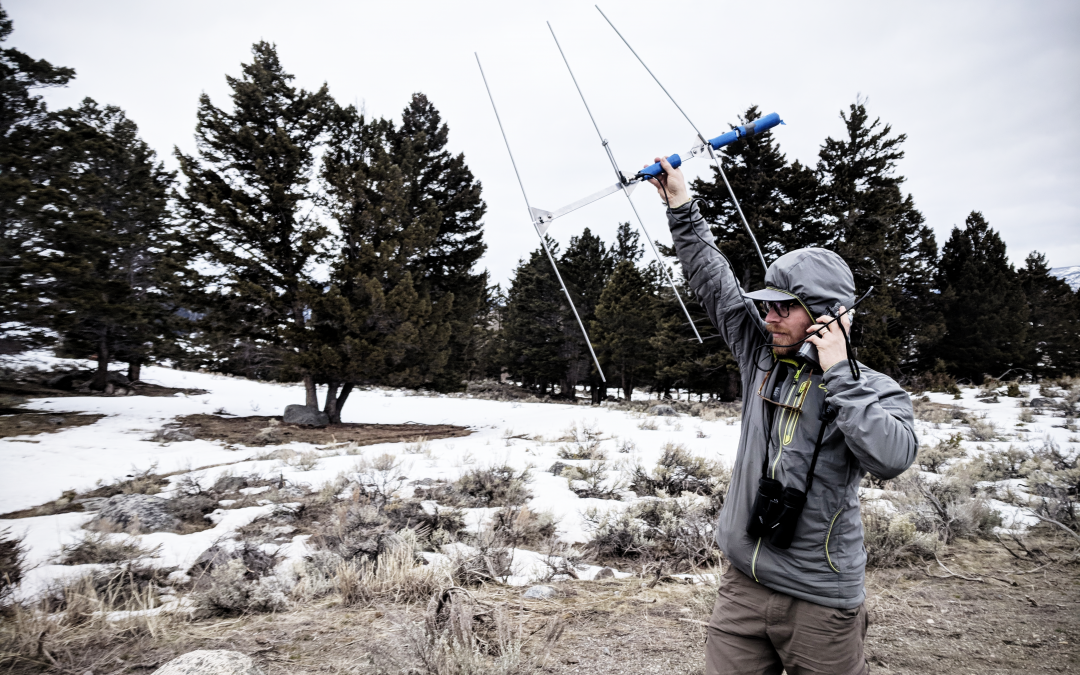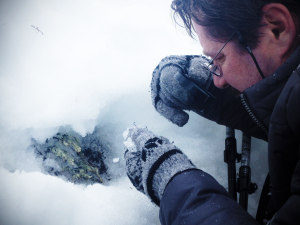By. Adam Bavier, Ecology Project International
It was the fourth morning of our Teacher Fellowship and the snow was so pristine, light, and fresh, that the long line of our crew floated across the butte without much trouble. This was good. When tracking bison along the northern range of Yellowstone in winter, you cannot have too much gratitude for gentle conditions, and the yellow sun peering down from a clear sky over diamond white hills promised a day full of possibility.
Snowshoeing is always a challenge. The labor of it exists on a continuum from exciting to drudgery, and the quality of the snow means much. When the surface takes on a hard and icy crust and your feet punch through to disappear so that each step buries you up to your knee, you tug and pull yourself free and smile and laugh from the futility and effort. When the rain falls overnight and freezes the snowpack hard and slick and thin, your snowshoes have no bite so that you slip and slide and careen through the forest and smile and laugh from the loss of control. And when the powder drifts deep and dry and offers sound loft, you bounce and float along the surface like a Canada lynx, the enormous paws of which your snowshoes mean to mimic, and you smile and laugh at the feeling of flight and freedom. There is no better way to connect with the landscape than working on a field team in winter, and while the conditions vary daily, there is always cause for joy.
Armed with telemetry equipment, snowshoes, and curiosity our team was working to locate a bison that had been radio collared the previous autumn. There are a historically high number of bison in Yellowstone National Park but only a handful in our study, and we were looking for a single individual to find and sample from. One among thousands. We were after quality data in the world’s first national park, and the snow held us aloft.
On this particular day, our field team was made up of educators from across the U.S. At Ecology Project International (EPI), we partner students local to areas of conservation concern with researchers studying those conservation issues in the field. In our Yellowstone program, we work with communities throughout the Greater Yellowstone Ecosystem, training students in the methods and protocols of National Park Service wildlife studies, and then taking them out into the field to collect data. They spend days in the park, living and working as field technicians and contributing to research projects used to make real-world management decisions across Montana, Wyoming, and Idaho.
Twice a year, we invite teachers from around the globe to participate in a Teacher Fellowship, an eight-day field experience where we engage in the same research work that our students tackle, while taking time each day to discuss teaching philosophy and science education best practices. Teachers, like students, need the chance to experience critical ecosystems first-hand to teach about their importance to global health. The learning experience is genuine, and the research robust.
This particular group was eager to share their enthusiasm: Laura’s expressive “this is so AWESOME” before and after each step in the research work or Jamie’s pervasive optimism even with gloved hands covered in sampling material (bison scat).
But it was Misty, from Illinois, who was having the most exciting morning. In her own words, “This week was an experience that has not only enhanced my perspective on conservation education but has changed me as a person. I have developed a deep love for this land and the activities learned. I am moved to get my students outdoors in all seasons. Snow science and winter experiences can be powerful.” You could see that change in Misty each day as we set out to work. The best technicians are competitive in their data collection; they view quality field data as a priceless treasure to be found, a cherished prize to be won. Misty had been bitten by that bug, and her playful energy and determined smiles helped drive our group forward. She WANTED to find that bison!
I smiled too, thinking about the lucky students in her classroom, in the classrooms of all our fellows, who in only a few days would welcome back their intrepid teachers with boundless energy and a thousand questions. The teachers would return champions, exhausted in body but refreshed in spirit, ready to help forge in their students the same connections they made to Yellowstone.
Just as it is impossible to cross a snow field and leave no track, it is impossible to cross this ecosystem and leave unchanged. It leaves its mark on you, and it is our hope that that impact, of landscape on person, is powerful enough to ignite transformational change. We see it happen in our students, we see it in our fellows, and it is thrilling to imagine that impact, growing and swelling and spreading, across districts and across lives. I was excited for Misty and for her students and her school and her administration. Like technicians across the landscape, influence travels, and one can never be quite sure how far it will go.
And so we continued on, stopping often to sweep with radio antenna and listen carefully to static from the receiver, hungry to hear the soft, rhythmic blips that indicate which direction our study animal lies. The group bounced amiably atop the snow as the equipment was passed around so that each teacher got a turn practicing the art of it. Curiosity set in as they waited. Some glassed the landscape with binoculars in the same spirit of inquiry we hope to illicit among our students. Others preferred to get in close, bringing a fir cone or a snow crystal up near to their eye for a change in perspective and scale.
Yellowstone is full of mystery and the participants who have the most meaningful experiences often leave with more questions unanswered than facts learned. Knowledge is vital, but it is the science process skills we practice in the field – asking and identifying relevant questions, constructing meaning from observation, following a method – that are the educational gems from a field course in Yellowstone. Participants have an incredible backdrop to pursue their interests, get hands-on, make (and correct) mistakes, all while a member of the group casts our aluminum wand back and forth across the Wyoming landscape, angling for a signal.
Ecology Project International’s Teacher Fellowship offers field-based professional development opportunities to educators throughout the world. In 2019, Fellowship programs will be held in Costa Rica, Hawaii, Baja, and Yellowstone. The program is currently accepting educator applications until September 1, 2018 at www.EcologyProject.org/fellowship
Author Bio
Adam Bavier has been with Ecology Project International since 2014, facilitating student-led research trips across the Greater Yellowstone Ecosystem. He has also spent time working at Mount Rainier and Joshua Tree National Parks. He is presently a graduate student at Montana State University studying science education and spends as much time as possible teaching and learning in wild spaces.


